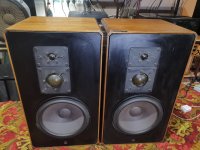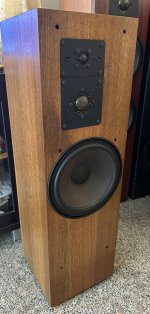Design comparison between two speakers: ADS L880 and ADS L990.
They are both three-way type. The L880 was launched before the L990 (1983 vs. 1986).
L880
Woofer: 10” cone dia., 2” voice coil, paper cone
Midrange: 2” dome dia., air cooling, woven soft dome
Tweeter: 0.75” dome dia., ferrofluid cooling, woven soft dome
Crossover points: 550 and 5kHz, 12dB/octave all
L990
Woofer: 10” cone dia., 1.5” voice coil, paper cone
Midrange: 1.5” dome dia., ferrofluid cooling, woven soft dome
Tweeter: 0.75” dome dia., ferrofluid cooling, woven soft dome
Crossover points: 700 and 3kHz, 12 pdB/octave all
I own both of them. I can say their sound is completely different. And I used to have a short talk with a retired engineer of ADS. He told me that these speakers received designs in different eras in which ADS transited computer aided system; HP vs. IBM for L880 and L990, respectively.
Anyway, I’d like to ask everyone’s opinions, except sound preferences, which design do you prefer and why?
They are both three-way type. The L880 was launched before the L990 (1983 vs. 1986).
L880
Woofer: 10” cone dia., 2” voice coil, paper cone
Midrange: 2” dome dia., air cooling, woven soft dome
Tweeter: 0.75” dome dia., ferrofluid cooling, woven soft dome
Crossover points: 550 and 5kHz, 12dB/octave all
L990
Woofer: 10” cone dia., 1.5” voice coil, paper cone
Midrange: 1.5” dome dia., ferrofluid cooling, woven soft dome
Tweeter: 0.75” dome dia., ferrofluid cooling, woven soft dome
Crossover points: 700 and 3kHz, 12 pdB/octave all
I own both of them. I can say their sound is completely different. And I used to have a short talk with a retired engineer of ADS. He told me that these speakers received designs in different eras in which ADS transited computer aided system; HP vs. IBM for L880 and L990, respectively.
Anyway, I’d like to ask everyone’s opinions, except sound preferences, which design do you prefer and why?
Attachments
Different computers can not result in different sound of those two loudspeakers, even if they use different loudspeaker simulation software - it is solely on the loudspeaker designer.
It is impossible to say which one of those two loudspeaker is better, sound quality depends on much more parameters than diameter of the mid dome and crossover frequencies.
With nothing else in sight, I would choose ADS L880 because of the larger mid dome (lower mid/bass crossover frequency - 550 Hz vs 700 Hz) and higher mid/tweeter crossover frequency (5 kHz crossover is much easier on the 0.75" tweeter than 3 kHz).
Of course, L880 might have worse sound than L990. Can you measure them?
It is impossible to say which one of those two loudspeaker is better, sound quality depends on much more parameters than diameter of the mid dome and crossover frequencies.
With nothing else in sight, I would choose ADS L880 because of the larger mid dome (lower mid/bass crossover frequency - 550 Hz vs 700 Hz) and higher mid/tweeter crossover frequency (5 kHz crossover is much easier on the 0.75" tweeter than 3 kHz).
Of course, L880 might have worse sound than L990. Can you measure them?
Sorry, I'm inconvenient to do that at present.Can you measure them?
And yes, I prefer L990 to L880.
About the question, I have been thinking that using a smaller voice coil on woofer and midrange and moving the crossover point between them a little bit higher would be an advantage. The smaller midrange may need assistance to reduce its low frequency reproduction task and adding some ferrofluid to it will help it further. For the woofer, to my understanding, the smaller voice coil may have less tolerance to power input, it may be easier for the unit to reproduce higher frequency though. Yet, I'm not sure about the lower end (deep bass) reproduction of the smaller v/c woofers if it would be degraded or not--using dual woofers format may solve the problem, Lol. Anyway, moving crossover point higher may help relief this issue. All in all, I'm still not sure whether my understanding is correct, so I came asking here for clarification/confirmation from the gurus in this forum.
Last edited:
Adding ferrofluid to mid will improve power handling (better cooling of the voice coil), but that will not change for better the low frequency response of the mid driver.
Different woofer voice coil diameters (1.5" and 2") have no impact on sound quality because crossover frequency between woofer and mid is low (550 or 700 Hz). But 2" woofer voice coil may withstand more power.
Different woofer voice coil diameters (1.5" and 2") have no impact on sound quality because crossover frequency between woofer and mid is low (550 or 700 Hz). But 2" woofer voice coil may withstand more power.

